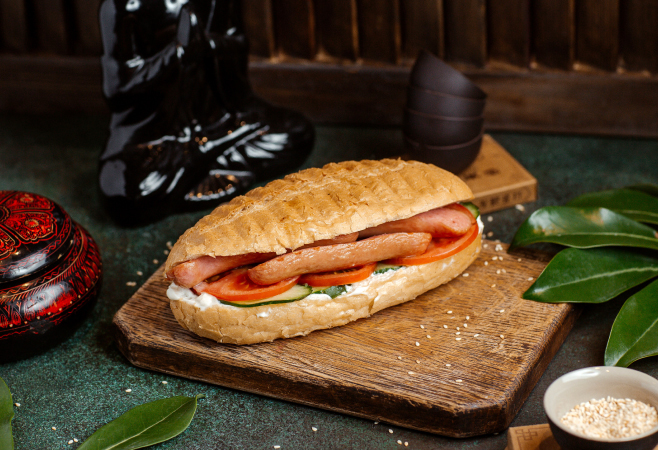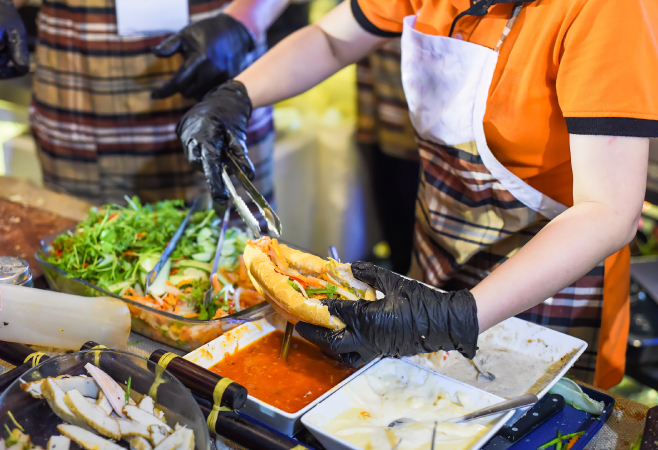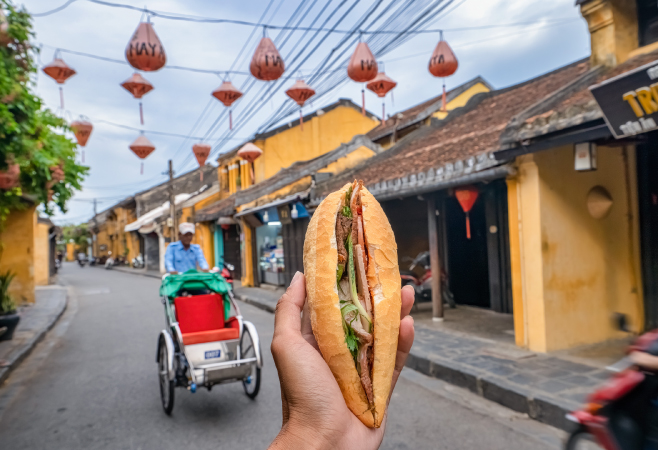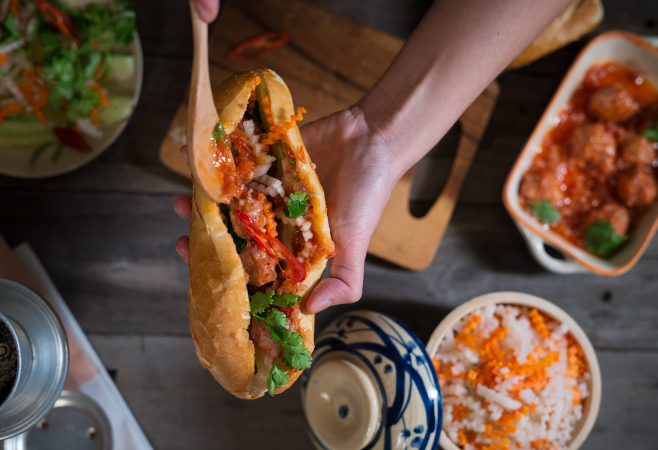What is Banh Mi? The Best Street Food of Vietnam Cuisine
In the realm of global cuisine, there are certain dishes that transcend borders, captivating the taste buds with a harmonious blend of flavors and textures. One such culinary masterpiece is the Banh Mi, a Vietnamese sandwich that has gained international acclaim for its unique combination of ingredients and cultural significance.
No one who comes to Vietnam can resist the renowned Banh Mi Sandwich, celebrated for its exceptionally flavorful taste that surpasses any sandwich found in Western countries.
So, what is Banh Mi? We will explore the origins, components, and cultural impact of Banh Mi, exploring why this humble sandwich has become a global gastronomic sensation.
Origins of Banh Mi
Why is it called the banh mi?
The term "Banh Mi" literally translates to "bread" or "wheat cake" in Vietnamese, reflecting the fundamental role of the baguette in this iconic sandwich. However, Banh Mi, as we know it today, is a product of a fascinating culinary fusion that unfolded during Vietnam's complex history.
The brief history of Banh Mi
The French colonial period, which lasted from the mid-19th century until the mid-20th century, significantly influenced Vietnamese cuisine. The introduction of the baguette, pâté, and mayonnaise by the French left a lasting impact on local culinary traditions. The Vietnamese people ingeniously adapted these elements, incorporating their own flavors and ingredients, giving rise to the Banh Mi we recognize today.
The distinctive Banh Mi style as we know it today was born on the bustling streets of Saigon (now Ho Chi Minh City). It was in this vibrant city that the fusion of French and Vietnamese culinary elements gave rise to the iconic sandwich. The baguette became the vessel for a harmonious blend of Vietnamese flavors and French influences.

Vietnamese Banh Mi is influenced by the French
Banh Mi nowadays
Following the fall of Saigon in 1975, a large influx of Vietnamese refugees escaping the Vietnam War settled in major American and European cities, introducing bánh mì to their new communities. Gradually, the Vietnamese sandwich gained immense popularity, evolving into an international sensation. Presently, bánh mì is readily available in restaurants, bakeries, street stalls, and food trucks worldwide!
What is Banh Mi made of? Making the best Banh Mi Sandwich
Banh Mi is a sandwich featuring a crusty baguette filled with a diverse array of ingredients. What makes Banh Mi truly exceptional is the harmonious marriage of textures and flavors within its layers. Get ready for a slight sensation in your stomach and captivating visuals of Vietnam's most delightful cultural offering.
Basic Ingredients - What is in Banh Mi?
-
A loaf of baked bread with a warm, crispy crust (made from rice or wheat flour, or a combination of both).
-
Pâté (A rich and savory spread made from liver, adding depth and flavor).
-
Proteins (such as cold cuts, grilled meat, cheese, eggs, or tofu).
-
Pickled vegetables (carrots and daikon or white radish, typically preserved in a mixture of boiled white vinegar, sugar, and salt, left to marinate for a few hours or days).
-
A selection of fresh vegetables (including cucumber slices, cilantro, and chili).
-
A spread (which may consist of mayonnaise, margarine, or cheese).
-
Various condiments (like soy sauce, fish sauce, or chili sauce).

The ingredients of Banh Mi is easy to prepare
Making the delicious Vietnamese Banh Mi
To make a mouthwatering Vietnamese Banh Mi at home, begin by preparing the pickled vegetables – julienned carrots and shredded daikon radish marinated in a mixture of rice vinegar, sugar, and salt.
Next, cook your chosen protein, whether it's grilled pork, shredded chicken, beef, or tofu, with flavorful Vietnamese spices. Meanwhile, preheat the oven and warm the French or Vietnamese baguette for a few minutes. Assemble the Banh Mi by spreading liver pâté and mayonnaise on the bread and adding the cooked protein, pickled vegetables, fresh cucumber slices, cilantro leaves, and optional chili.
Lastly, Drizzle with soy sauce, fish sauce, or chili sauce to taste. Your homemade Banh Mi is ready to be savored, offering a delightful fusion of textures and flavors in every bite.
Some Available Banh Mi Types in Vietnam
Numerous iterations of the Banh Mi exist, distinguished by diverse and region-specific fillings, all centered around the ubiquitous Banh Mi loaf. Let's journey southward and explore six renowned and distinctive renditions of this sandwich that have significantly played a role in elevating its status on the global culinary stage.
Banh Mi Chao Hanoi
In Hanoi, a widely embraced method of enjoying the Banh Mi involves presenting it alongside a sizzling pan of hot toppings, giving rise to the name Banh Mi Chao. This culinary practice is believed to have its roots in French dining customs, where the Banh Mi and accompanying toppings are served separately and using a knife and fork to eat.

Banh Mi Chao
Banh Mi Hoi An
For most tourists, when thinking about Vietnamese sandwiches, Banh Mi Hoi An likely comes to mind first. It has gained widespread recognition through appearances on national Korean TV shows and endorsements from renowned food critics and celebrities. However, its popularity is rightfully earned. The crucial component of an excellent sandwich is, undoubtedly, the Banh Mi itself. In Hoi An, this sandwich stands out with a distinctive shape—smaller and more pointed on the two sides than in other regions of the country. These Banh Mi are consistently freshly baked, resulting in an exceptionally crispy crust on the outside while maintaining moist and soft ingredients.

Banh Mi Phuong in Hoi An
Banh Mi Op La
Banh Mi Op La, commonly known as Fried Egg Banh Mi, is a Vietnamese sandwich that adds a delightful twist with the inclusion of a fried egg. This breakfast or anytime snack is often served with additional ingredients like pate, Vietnamese sausage, fresh herbs, and pickled vegetables, contributing to a harmonious blend of savory and fresh tastes. Banh Mi Op La is a simple yet satisfying choice that highlights the versatility of Vietnamese cuisine.
Banh Mi Xiu Mai
Banh Mi Xiu Mai, or Meatball Banh Mi, is a delightful Vietnamese sandwich originating from Dalat. Unlike traditional Banh Mi, it features small and flavorful meatballs made from minced pork and wood-ear mushrooms. Served in the misty and cool weather of Dalat, the freshly baked Banh Mi is accompanied by a bowl of xiu mai soup, chewy pork skin, steamed pork sausages, and fresh coriander. What sets it apart is the warmth of the xiu mai soup and a hint of heat from minced chilies. To enjoy, one tears the Banh Mi into pieces, dipping them into the comforting soup for a flavorful experience that captures Dalat's culinary charm.

Banh Mi Xiu Mai
Banh Mi Heo Quay
Banh Mi Heo Quay (Crispy Roast Pork Banh Mi) has crispy and savory pork complemented by the customary Banh Mi accompaniments, including a French baguette and a medley of fresh and pickled vegetables. The result is a satisfying and flavorful sandwich that perfectly balances the crunchiness of the roast pork with the softness of the bread and the vibrancy of the vegetables.
Conclusion
From its humble origins in Vietnam to its global popularity, Banh Mi embodies the essence of gastronomic evolution. Each bite of this sandwich is a symphony of flavors, a testament to the creativity and ingenuity of those who have contributed to its rich culinary tapestry. As we continue to explore and appreciate global cuisines, Banh Mi stands as a shining example of how food has the power to bring people together, transcending borders and fostering a shared appreciation for the art of flavor.
Related Articles
- Moc Chau: Highland paradise of tea hills & cultural adventures
- Team building and CSR activities in Vietnam: Visa services
- Honeymoon in Vietnam: Best romantic packages for couples
- Amanoi Resort in Vietnam: Luxury retreat in Vinh Hy Bay
- Six Senses resorts in Vietnam: Ninh Van Bay and Con Dao
- Con Dao Island: A historical and natural paradise in Vietnam
- Michelin Guide in Vietnam: Ho Chi Minh City, Da Nang, Hanoi
- Vietnam vs Thailand: A comparison for Southeast Asia escape
HOW CAN WE HELP?
APPLY WITH CONFIDENCE










